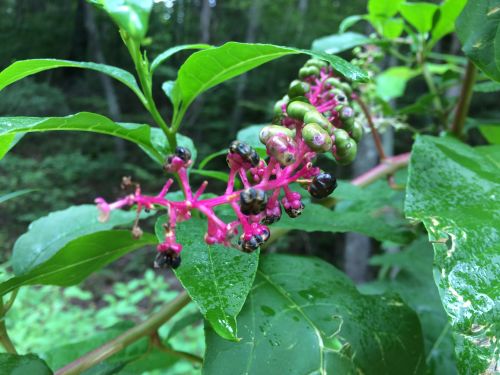★★★★★
======ORH=======
Poke Herb Photos
★★★★★
You didn't mention in your medicinal review of Polk, that you can EAT it....it is so good. Young leaves as you describe, cooked like you would spinach. Yum. With cornbread of course. (NOT older leaves which apparently begin to turn toxic. Once I nibbled on an older leaf...just a bare taste, and got a bit nauseous.)
Poke Herb Photos
★★★★★

Poke is tall now in TN; some plants are 6 feet tall!
This picture shows the bright magenta berry stem. Most of these berries have been picked clean by the birds. They will digest all but the seeds and then pass the seeds along for new poke plants next spring. The seed is the most dangerous part.
The green berries are not ripe. The deep purple berries are ripe. Some people will swallow a berry a day and let the seed pass through (the seed is the most toxic part, other than the root.) The berry a day is for arthritis.
Poke root tincture is used by some for Lyme disease, a DROP at a time. (Not a dropperful.)
Poke root oil is used for breast tumors.
In the spring the leaves used to be boiled in three changes of water for a "tonic" food. If the plant is taller than a foot, the plants are too old to harvest the leaves, so they say.
Poke berries make a fun homemade ink for children, with supervision of course.
Poke is a perfect example of "the dose makes the poison." Poke is classified as poisonous, but when used carefully by those who know what they are doing it can be a great benefit.
~Mama to Many~



